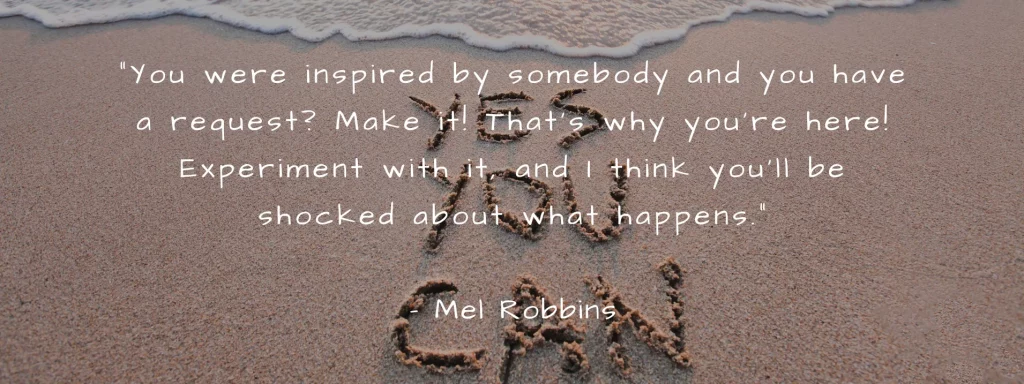From Resistance to Embracing Mel Robbins #5SecondRule
Podcast: Play in new window | Download | Embed
“You were inspired by somebody and you have a request? Make it! That's why you're here! Experiment with it, and I think you'll be shocked about what happens.”
Mel Robbins
Sometimes we humor our knee-jerk reactions of resistance too much. In this episode, I talk about Mel Robbins’ The 5 Second Rule, explaining why and how to listen more to our good impulses before doubts have a chance to creep in.
I summarize Mel’s thesis that, if you don’t physically act on an impulse within five seconds, you kill it. I explain why I initially resist her message and why I’ve been converted. I note the power of counting backward, explaining why it’s effective, and I explore the different ways to use the #5SecondRule.
This Week on The Mindset Zone:
- Mel Robbins’ 5 Second Rule
- Why your problem isn’t that you don’t have enough ideas
- Why counting down to the moment of action is effective
- The different ways to use the 5 Second Rule
- How a triangle can help us change
Resources Mentioned:
Expand what's possible!
Transcript of this episode:
I still remember clearly, walking down the stairs in my family house where I grew up in Portugal, thinking about something I wanted to do.
Without saying anything to my mom about my desires she would somehow suggest the same thing I had been thinking.
And just like that, her suggestion was the kiss of death to my desire. Maybe this is typical teenage resistance. Annoying as it must have been to my mother, perhaps my resistance was good, a sign I wanted to create my own way and identity.
Fast forward to the present time, now in my late forties, I still sometimes get the knee-jerk reaction of resisting things that are good for me.
In 2021, I had come across the work of Mel Robbins several times, by references to her book “The 5 Second Rule,” her keynotes, or interviews she did in podcasts and other media. My first impression of Mel was very positive. I like her high energy and go-getter attitude. My curiosity was further sparked by her telling the story that her 5-second rule was almost an after-thought to end her now-famous TEDx “How to stop screwing yourself over.” So, I decided to watch it. I thought she had done a great job and found the 5-second rule concept interesting. Mel explains:
“If you have one of those little impulses that are pulling you, if you don't marry it with an action within five seconds, you pull the emergency brake and kill the idea. Kill it!
If you have the impulse to get up and come dance while the band is playing, if you don't stand up in five seconds, you're going to pull the emergency brake.
If you have an impulse about, you were inspired by somebody's speech today, and you don't do something within five seconds – write a note, send yourself a text –anything physical to marry it with the idea, you will pull the emergency brake and kill the idea.”
She follows up by saying, and I absolutely love this part:
“Your problem isn't ideas. Your problem is you don't act on them.
You kill them. It's not my fault. It's not anybody's fault.
You're doing it to yourself. Stop it!”
Then, she goes on to challenge the audience:
“I want you to practice the 5-second-rule. You see somebody and you think you have an impulse, they look interesting? Walk over there!
You were inspired by somebody and you have a request? Make it! That's why you're here!
Experiment with it, and I think you'll be shocked about what happens.”
I love this challenge to action. It's a great example of how we can start the change process through a simple act – just doing it!
But do you need a book, a 240-page book to explain what Mel did so clearly in 2-minutes in her talk?
So, I initially resisted getting the book, but because references to it keep popping up in several places, and Mel Robbins is one of the most sought-after motivational speakers in the world, and the book sold over a million copies and was translated at least into 32 languages, I decided to listen to it in Audible.
I love her story, how Mel discovers the 5 Second Rule, and the realization that knowing what you need to do isn't enough to create change. As I like to say, insight is not enough.
It was powerful to listen to how she struggled to get out of bed each morning. How she never felt like getting up, how hitting the snooze button was a habit so difficult to break, and how the 5-second rule changed that.
It was interesting to learn how research supports the 5-second rule, the moment you have the instinct to act on a goal that is important to you, you can count backward 5-4-3-2-1 and physically move or your brain will stop you with excuses, fears, and anxiety.
As Mel put it:
“Whenever you feel an instinct fire up to act on a goal or a commitment, or the moment you feel that yourself hesitate on doing something and you know you should do, use the Rule. Start by counting backward to yourself: 5- 4- 3- 2- 1. The counting will help you focus on the goal or commitment and distract you from the worries, thoughts, and fears in your mind. As soon as you reach “1,” move. That’s it. It’s so simple but let me hammer this home one more time. Anytime there’s something you know you should do, but you feel uncertain, afraid, or overwhelmed…just take control by counting backward 5- 4- 3- 2- 1. That’ll quiet your mind. Then, move when you get to “1.” “
It all made sense, but I kept resisting, with a startling resemblance to my teenager self’s defiant and annoying “I can do better” attitude. I have two masters and a Ph.D. in Psychology. I'm a Board Certified Coach and an expert in human potential, I know many different avenues of helping people change. This can be one way, but there are other ways too. Sure, but the reality is that even being able to wake up early, I couldn't break my habit of hitting the snooze button, and the idea of implementing the 5-4-3-2-1-launch out of bed to begin my day started to grow on me.
So, more than halfway through the book I decided to give it a try. Why not? And, guess what? It worked! And 30 days later it still works!
The proof was in the pudding.
I wake up earlier without hitting the snooze button, started owning my mornings–another concept from the book.
Suddenly, I had time to do yoga, and start running again.
Powerful stuff. Why had I resisted so long? I began to recriminate myself but recognized I was falling into the trap of my critical voices, so I decided to use the 5-second rule in a different way: 5-4-3-2-1-be gentle with myself.
I'm now embracing the 5-second rule to help me stop and start all kinds of things and that's what counts.
I often invite people to see their thoughts, feelings, and behaviors as a triangle, instead of seeing them in a linear, unidirectional way. Imagine a triangle with one side representing our thoughts or mindsets, another our feelings or emotions, and the other our actions or behaviors. If a triangle loses one of its sides, it ceases to exist.
The same thing is true of the change you want to create in your life.
Change happens when you think, feel, and act it into being so. And you can start the change process by entering any of these three sides in any order at any time, and shifting one side will change the other sides too. The 5-second rule is a great example of starting the change process with a simple action that can lead to a powerful mindset shift. And, we can expand a lot of possibilities this way.
As Mel Robbins says it:
“Just Do It” is a concept—it’s what you need to do. The #5SecondRule is a tool—it’s how you make yourself do it.
So if you feel inspired to know more about the 5-second rule, go ahead and get the book, or go listen to Mel's TEDx. Just 5-4-3-2-1-and expand what's possible!









